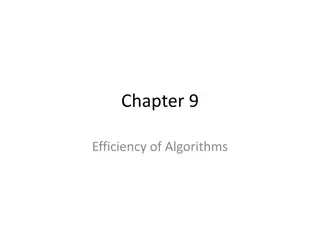Examples of List Comprehensions and Notations
This content provides examples and explanations of list comprehensions, mathematical notations, ways to convert Centigrade to Fahrenheit, syntax, semantics, and types of comprehensions. It covers topics such as expressing lists, mathematical sets, and efficient Python techniques. Learn how to easily generate lists, perform mathematical operations, and iterate through sequences.
Download Presentation

Please find below an Image/Link to download the presentation.
The content on the website is provided AS IS for your information and personal use only. It may not be sold, licensed, or shared on other websites without obtaining consent from the author.If you encounter any issues during the download, it is possible that the publisher has removed the file from their server.
You are allowed to download the files provided on this website for personal or commercial use, subject to the condition that they are used lawfully. All files are the property of their respective owners.
The content on the website is provided AS IS for your information and personal use only. It may not be sold, licensed, or shared on other websites without obtaining consent from the author.
E N D
Presentation Transcript
List comprehensions UW CSE 140 Winter 2014 1
Ways to express a list 1. Explicitly write the whole thing: squares = [0, 1, 4, 9, 16, 25, 36, 49, 64, 81, 100] 2. Write a loop to create it: squares = [] for i in range(11): squares.append(i*i) 3. Write a list comprehension: squares = [i*i for i in range(11)] A list comprehension is a concise description of a list A list comprehension is shorthand for a loop 2
Mathematical notation Let I be the integers { x : x I and x = x2 } is the set { 0, 1 } { x : x I and x > 0 } is the set of all positive integers { x2 : x Iand 0 x < 10 and prime(x) } expression variable domain condition Python notation: { x*x for x in range(10) if prime(x) } expression variable domain condition 3
Two ways to convert Centigrade to Fahrenheit ctemps = [17.1, 22.3, 18.4, 19.1] With a loop: ftemps = [] for c in ctemps: f = celsius_to_farenheit(c) ftemps.append(f) With a list comprehension: ftemps = [celsius_to_farenheit(c) for c in ctemps] The comprehension is usually shorter, more readable, and more efficient 4
Syntax of a comprehension [(x,y) for x in org1 for y in org2 if sim(x,y) > threshold] expres- sion for clause (required) assigns value to the variable x zero or more if clauses zero or more additional for clauses something that can be iterated 5
Semantics of a comprehension [(x,y) for x in org1 for y in org2 if sim(x,y) > threshold] result = [] for x in org1: for y in org2: if sim(x,y) > threshold: result.append( (x,y) ) useresult 6
Types of comprehension List [ i*2 for i in range(3) ] Set { i*2 for i in range(3)} Dictionary d = {key: value for item in sequence } { i: i*2 for i in range(3)} 7
Preparing names for alphabetization Goal: convert firstname lastname to lastname, firstname names = ["Isaac Newton", "Albert Einstein", "Niels Bohr", "Marie Curie", "Charles Darwin", "Louis Pasteur", "Galileo Galilei", "Margaret Mead"] With a loop: result = [] for name in names: split_name = name.split(" ") last_name_first = split_name[1] + ", " + split_name[0] result.append(last_name_first) With a list comprehension: split_names = [name.split(" ") for name in names] last_names_first = [sn[1] + ", " + sn[0] for sn in split_names] # Bonus: last_names = [split_name[1] for split_name in split_names] Another idea: write a function, then use the function in a comprehension 8
Cubes of the first 10 natural numbers Goal: Produce: [0, 1, 8, 27, 64, 125, 216, 343, 512, 729] With a loop: cubes = [] for x in range(10): cubes.append(x**3) With a list comprehension: cubes = [x**3 for x in range(10)] 9
Powers of 2, 20 through 210 Goal: [1, 2, 4, 8, 16, 32, 64, 128, 256, 512, 1024] [2**i for i in range(11)] 10
Even elements of a list Goal: Given an input list nums, produce a list of the even numbers in nums nums = [3, 1, 4, 1, 5, 9, 2, 6, 5] [4, 2, 6] [num for num in nums if num % 2 == 0] 11
Gene sequence similarity Goal: Find all similar pairs of genome sequences (one sequence from org1, one from org2) org1 = ["ACGTTTCA", "AGGCCTTA", "AAAACCTG"] org2 = ["AGCTTTGA", "GCCGGAAT", "GCTACTGA"] Similar means: similarity(seq1, seq2) > threshold def similarity(sequence1, sequence2) """Return a number representing the similarity score between the two arguments"" ... [(s1,s2) for s1 in org1 for s2 in org2 if similarity(s1,s2) > threshold] 12
All above-average 2-die rolls Result list should be a list of 2-tuples: [(2, 6), (3, 5), (3, 6), (4, 4), (4, 5), (4, 6), (5, 3), (5, 4), (5, 5), (5, 6), (6, 2), (6, 3), (6, 4), (6, 5), (6, 6)] [(r1, r2) for r1 in [1,2,3,4,5,6] for r2 in [1,2,3,4,5,6] if r1 + r2 > 7] OR [(r1, r2) for r1 in range(1, 7) for r2 in range(8-r1, 7)] 13
Get more practice Use comprehensions where appropriate Convert loops to comprehensions Convert comprehensions to loops 14























